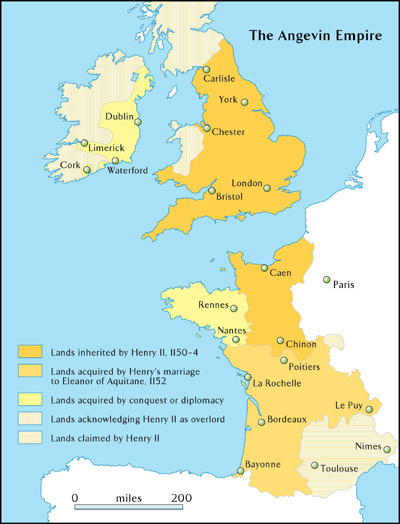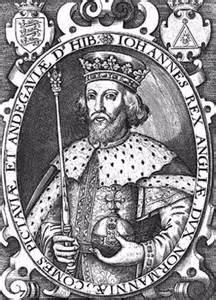King John: England's Oft-maligned Monarch
King John is one of England's most-remembered kings for two reasons, neither of which he would have liked. He is known as the king who gave up his ultimate authority in authorizing Magna Carta, and he is known as the villain in the Robin Hood stories. John was born in 1166 to King Henry II and Queen Eleanor (of Aquitaine). John wasn't his father's first son but became his father's favorite. Early on, John was given the name Lackland because his father lacked land to give his new son, having assigned it all to his other sons, William, Henry, Geoffrey and Richard. John's older three brothers died young, however, and the young Lackland was old enough to rule over lots of land when his father died, in 1189, leaving Richard as king. John had also been appointed Lord of Ireland, following an unsuccessful rebellion by his older three brothers. Not old enough for the responsibility, though, John didn't qualify as a good administrator. He was good at playing games, for money, and at collecting expensive clothing and jewels. He was also very good at hunting game. 
When Richard Plantagenet became King Richard I, he set about raising money and men to take part in the Third Crusade, one of a series of Christian campaigns to win back control of the Holy Land, which had been absorbed by the Muslim expansion in the few centuries since the death of the Prophet Muhammad. While Richard was away, John tried to find support for overthrowing his brother and installing himself as king. The rebellion went nowhere, and John was viewed with suspicion by many in England. When Richard died, however, in 1199, John was proclaimed king. The other claimant to the throne at that time was Arthur of Brittany, John's nephew and a son of John's brother Geoffrey. Arthur had the support of the French king, and these two men united to make life difficult for John's reign. When John was crowned king, England had control of large parts of what is now France; this was referred to as the Angevin Empire. Early on in his reign, John made peace with the French king Philip II, in the Treaty of Le Goulet. This solidified the English hold on French lands for a time. However, the peace didn't last long, for a variety of reasons, including French complaints about John's instructions for treatment of French prisoners. The battles started anew, and French troops won a series of battles during the next few years, resulting in an eventual French re-possession of nearly all lands once owned by England. During and after these battles, John proclaimed a series of new taxes that the English (landowners, especially) were required to pay to help finance the war. The king also was more easy to forgive debts owned by people he favored and, at the same time, be more insisting that those he disliked pay back all that they owed. This sort of favoritism gained the crown money to finance the ongoing wars but increased resentment among some key nobles who had lots of land and power. John as king took a keen interest in government and laws. He followed in the footsteps of his father and brother in proclaiming that the king had something of a divine mystique about him, something that set him apart from all of his subjects. As did previous kings, John served as head of the royal court that traveled around the kingdom, settling local disputes and matters of national importance. He spent a lot of time ensuring that the legal system was full of legal experts, not just people who liked the law. He also made it possible for common men to bring complaints to him directly rather than to the local baron. 
King John did not get along too well with the Catholic Church, either. He was often heard making blasphemous remarks, and he refused to take communion. His donations to the church were noticeably and publicly tiny. He quarreled with the pope of the time, Innocent III, over who would be the Archbishop of Canterbury. This quarrel resulted in the pope's excommunicating the king and banning certain worship services from English churches. John relented in the end, and the punishment was a series of financial levies that further drained the royal treasury. Keen to reclaim Normandy, John embarked on a series of revenue schemes. His predecessor and brother, Richard, had sold off many royal lands in order to raise money for the Third Crusade, so John could count on much less royal income from lands owned. However, he made up for this drop in income by encourage the scutage system, whereby fighting-age men could buy their way out of having to serve in the military by making a cash payment directly to the king. John levied scutage payments 17 times in his 17 years on the throne, compared to 11 levies issued by his three predecessors combined. John also set about making the crown money from the issuance of fees, the collection of court fees, and the sale of charters, especially for new cities. Making matters worse was a series of inflationary waves that increased prices on grain and animals and made silver hard to come by. In the latter part of his reign, John also entered into war with Wales, specifically with Llewelyn the Great, who was married to one of John's daughters, Joan. English forces ventured into Wales a few times, without much success. As the wars and new money-raising schemes dragged on, a group of barons had had enough and, early in 1215, took up arms against their king. This was not exactly a new phenomenon, but it had a new result. The barons captured London in May and then captured John himself at Windsor a few weeks later. The barons presented John with a list of demands that became Magna Carta. John affixed his royal seal to a list of these demands on June 15, and the barons renewed their oath of fealty to him on June 19, at a meadow in Runnymede, west of London. (Many of the provisions in Magna Carta appeared also in the Coronation Charter signed by King Henry I in 1100.) John had made the promises that became Magna Carta in order to avoid a wider confrontation. He didn't have any more money or support in June than he had in May, when the barons had occupied London. The king's intention not to abide by Magna Carta became evident not long after the "agreement." The result was another war, called the First Barons War, with the heir to the French throne, Prince Louis, invading England, capturing London, and proclaiming himself king, supported by a Scottish force led by King Alexander II who had marched the length of England to support Louis and the barons. Louis wasn't crowned, however, and the struggle for supremacy continued for several months. Returning to England after another defeat, John lost most of his prized possessions, including the Crown Jewels, in a freak storm. John had two wives who shared a first name: Isabella of Gloucester and Isabella of Angoulême. He also had five children: Henry, Richard, Joan, Isabella, and Eleanor. King John died in 1216 of dysentery, while on campaign in France. He was succeeded by his oldest son, who became King Henry III. King John in the Robin Hood legends King John was the subject of a tragedy by William Shakespeare. Other depictions of the king's life and life events followed. He was also portrayed unsympathetically in the well-known 19th Century novel Ivanhoe, by Sir Walter Scott. This novel also featured Robin Hood. The Sheriff of Nottingham, the main villain in the Robin Hood legends, would have been a personal friend of the king during John's reign (as were most of the sheriffs at the time), and it is likely that this is another way in which John's name became attached to the legends. John was also tasked with paying ransom for his brother, King Richard, who was captured on his way back to England after the Crusade. This would have been a large draw on the royal treasury. The story of Robin Hood as a staunch defender of Richard would necessarily have cast John, who actually tried to assume the throne in Richard's absence, as a villain. As the ballads and stories of Robin Hood became more popular, the maligning depictions of then-Prince John and the Sheriff of Nottingham would have proliferated. |
|
Social Studies for Kids
copyright 2002–2025
David White




